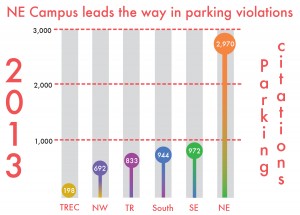By Jamil Oakford/editor-in-chief
NE Campus issues twice as many violations than all other TCC campuses combined in 2013
If students have violated any of TCC’s parking rules, they most likely happened on NE Campus.
NE student Reyana Mohamed admitted she’s parked in spots other than student parking.

Photo by Katelyn Townsend/The Collegian
“I’ve done it before,” she said. “I just haven’t been caught.”
Others have. NE Campus reported over 2,900 parking citations in 2013, according to the latest district data. The only campus that came even remotely close to that number was SE Campus with 972 citations.
This number comprises voided tickets as well as tickets that were issued. Lt. Terry Moak believes warnings issued might also make up this number.
“The most common parking violation we see are students parking in faculty spots,” Moak said. “The second would be students parking in visitor parking. It’s usually students from other campuses who come to NE and think because they’re visiting, they can park in visitor parking.”
For many students, the convenience of parking in spots closer to their classes is tempting, especially when strapped for time. This isn’t just specific to NE.
“There’s a lot more staff parking than needed,” SE student Stacy Kuywa. “It’s inconvenient, especially if you’re late for an exam, like I was today.”
Mohamed said that for NE, driving around and finding student parking is time-consuming, and parking in the faculty or visitor section cuts down on that time.
Showing up late to class on NE, especially during morning classes, means sometimes the only available parking is in the overflow lot across Grapevine Highway, which is a moderately far distance if early, but incredibly far if late.
So the convenience of parking between the wrong colors outweighs the possibility of a ticket for some students. Either way, it’s the job of the campus police or security guards to differentiate among students, faculty and visitors.
“Of course if they have a permit, they’re a student,” Moak said. “Usually when you see book bags or books in the backseat, that’s an indicator.”
Moak also mentioned that observation helps them with figuring out who’s a student. Because they patrol every day, they remember cars and can use how frequently and how long they’re parked to figure out if they’re going to classes.
But despite that, that isn’t a foolproof system.
“Most of the time, we really don’t know,” he said.
For NE student Diane Hendrix, she follows the rules, but she understands the temptation.
“It’s easier and faster,” she said. “Sometimes, you don’t pay attention.”
Evening and weekend classes set up for a different kind of parking situation for students.

“I take evening and weekend classes, and faculty parking is always empty, and I can see how someone would see it and say, ‘Hey, let me get that spot,’” Hendrix said.
Although Hendrix has flirted with the idea of parking closer, she believes it’d be just her luck that she’d get slammed with a ticket.
NE experienced a spike in citations between 2012 and 2013. The campus reported 1,350 in 2012. This number soared to well over 2,500 in only a year.
“It could have risen because we hired a security guard that year,” Moak said.
In 2013, every campus across the district hired campus security guards. On NE, security guards patrolled, their primary job to patrol for student safety, but they had more time to deal with parking violations.
“These security guards primarily deal with parking, door unlocks and building security,” he said.
One factor is the sheer number of students enrolled. NE has the highest enrollment of students than other campuses, topping out at approximately 12,000 students this spring semester alone. With 12,000 students competing for parking, issues are almost guaranteed.
Still when asked if the parking situation is better this year than it was in 2012 or 2013, Moak chuckled.
“It’s really about the same,” he said. “It’s always a struggle to keep students out of faculty spots.”
But when asked if any semesters present more of a problem, he agreed.
“Some semesters are worse than others,” he said. “Usually, the first month of classes is the worst.”
Because there are new students each semester, police have to deal with students who don’t know all the rules for parking in TCC’s lots.
And with patrol officers and campus security guards, their primary job isn’t to write tickets. Moak said they’d rather the officers and guards do more patrolling for student safety than for parking.
TR police Capt. William Ivie said parking on TR isn’t as big of an issue for him and his staff.
“Parking is definitely a concern, especially with limited visitor parking out front,” he said. “But what helps is the overflow parking garage on Belknap and Henderson to the west.”
The overflow parking is shared with Tarrant Regional Water District who uses it on the weekend while TCC uses it during the week.
For the money aspect of this, each parking citation can range from $5 to $10 depending on the type of violation, and there are at least 10 types of violations a student can make.
Assistant police chief Leigh Dietrich explained that once the ticket is paid, that money goes downtown.
“It comes back to the college,” she said. “It goes back into the TCC general fund.”
The tickets have to be paid for at the campus business services office and not the police department on campus.
According to the district report, NE’s 2,970 parking citations had a value of over $33,000 in 2012. So, in essence, the school would receive that money back.
NE student Chris Tran just finds following the rules to be easier and cheaper.
“I’ve been here almost a year, and I have no problems so far,” he said. “I make sure I’m in between the white lines. It’s really easy. Just white and yellow lines. That’s all.”



























